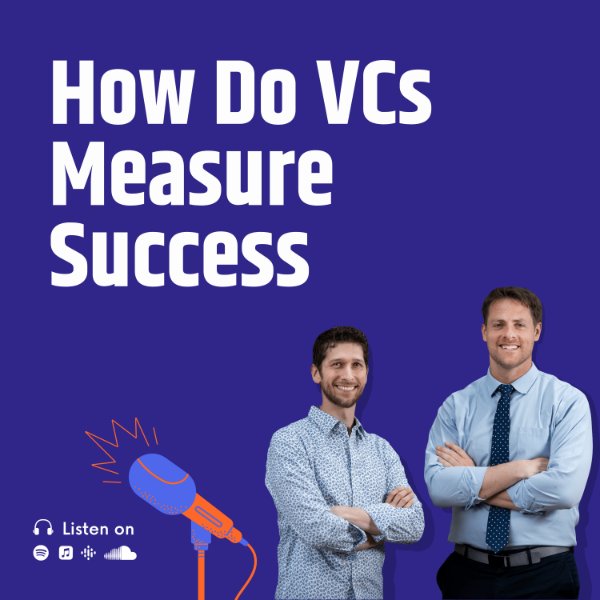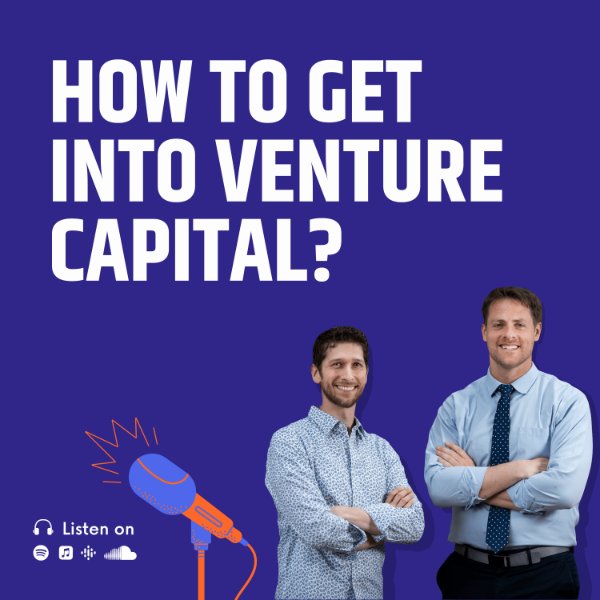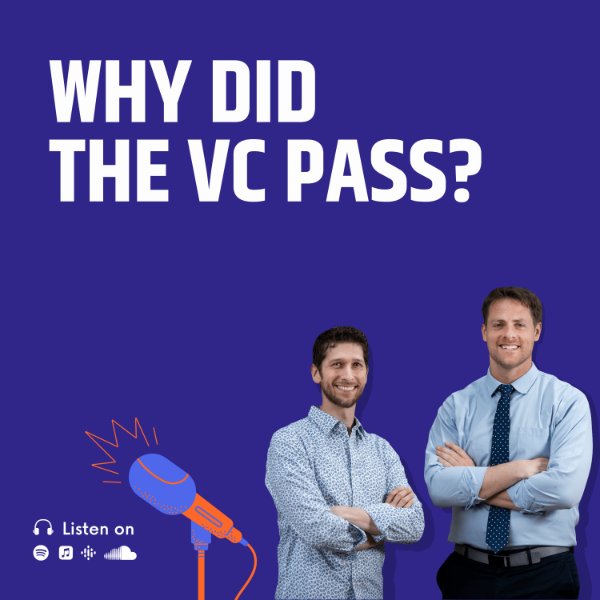Jon: All right. We see markdowns in 2022. So one of the interesting things that came out, our piece of news in the last week or so is that Canva, it's a company that does their kind of can Photoshop images, image creation, things like that was valued at $40 billion. And a VC fund called Blackbird wrote down their investment portfolio by 14.4 billion, like a 40% markdown.
Jon: And they used what they called a strength in valuation methodology. So let's talk about, Peter, what's happening in the market right now? What is a strength in valuation and methodology and what are other things that we should see and maybe even address it from like a regional perspective? You're ready to begin, go to venture capital firm. Also, if you guys want to subscribe to any of other channels besides YouTube, Spotify, Apple, things like that.
Peter: Well, I don't know what. I didn't read the report, so I don't know what they mean by strength and valuation. But I think what they're trying to say is, hey, everything is down a lot. We need to go back through our portfolio and we need to evaluate things the way that, you know, what would they have been worse and maybe 2019.
Peter: Right. Okay. so yeah, I mean, there's a lot of fun doing that. It's a tricky situation because on the one hand it really depends on what your valuation methodology is that you've agreed to with your limited partners or your investors, because you know, in some cases like you want to take the write downs now because everybody's expecting you to have write downs in the portfolio.
Peter: You want to take those write downs. Now you.
Jon: Don't. You're fundraising right now. Well, for another fund.
Peter: Yeah, but even if you are fundraising right now, like yeah you never want to take write downs but like what here's what you don't want to do is you don't want to like, not take the write downs, get a bunch of commitments. Six months later they do a priced round and then you get hit with the write down and there's like no question right that that it's gotten written down and now you're now you've got some explaining to do.
Peter: So you kind of want to be able to like get in front of it and be like, yeah, like we've written this down, right? But I think the flip side is some of these valuations, at least in our portfolio, have been set in the last like 3 to 4 months. So it's like really tricky. Like where do you draw that line?
Peter: Like we know that the companies probably aren't worth what they were worth, but by how much? I don't know. And I think a lot of VCs are in that same situation now. I think in the case of Canva, I haven't seen canvas numbers, but like in my mind, there's no way that they were realistically worth $40 billion, right?
Peter: Somebody who ever led that round had like a very optimistic view of what they could be worth someday. Right. And there was so much competition for that deal because it's such a hot deal that people were willing to kind of fight and pay up on valuation and kind of envision this like world that I think was pretty unlikely.
Peter: And I think Blackbird just looked down and said, Hey, you know, yeah, we were all like Peyton ourselves on the back when it hit 14 billion or 40 billion. But like, everybody knew that that was like kind of a crazy valuation. Let's bring it down to something more realistic. Let's be honest though, Like is $25 billion for an app that basically makes it easy to put together Instagram posts that look nice, like word for word, 25 billion.
Peter: I don't know. That seems kind of rich to me.
Jon: He still looks at the like the revenue stream.
Peter: Yeah, but we don't know it. I don't know what the revenue stream looks like. Right. But like you asked about the market. So overall, like valuations are down massively. And if, if I have one takeaway for any entrepreneurs that are listening to this podcast, it is that the I've talked to a lot of entrepreneurs at all levels, like all from seed all the way up to late stage growth and I keep hearing the same question, which is like, Hey, when do we get back to like those valuations we had last year?
Peter: Those are great. Like, when does that happen? And I'm like, I don't know if we ever get back to those valuations right? Like, those were like this anomaly in time where the Fed was printing tons, had just printed tons of money, was printing lots of money, government and spending tons of money. Everybody had tons of money in their bank accounts from like stimulus and so forth.
Peter: And everyone could raise a new like $20 billion fund, seemingly with like zero effort. And so there was an insane amount of money chasing a limited number of valuable companies. Right. And that just, of course, raised all boats, pushed all valuations really high. I was looking at the valuation report from Pitchbook. Okay. And what's crazy is you see these charts and it's, it's like fintech to that it a train like trending around median VC value for for fintech was bumping between 10 to $15 million for late stage growth and in 2021 jumped from that to almost 30.
Peter: Right so uses like da da da da bomb. And it's not just like fintech. You look at enterprise tech, same thing goes from 10 to 20 million. You go you look at consumer went from 10 to 14 so not as big but I mean consumers consumer, but historically they've been relatively flat. I mean, with a slight increase. And so look, I think ultimately what you're seeing in 2020 is like everything's dropping and frankly, it hasn't even dropped enough.
Peter: Like enterprise Tech has only dropped from 20 to 16. Realistically, it probably needs to drop another $6 million, right, for your average average deal that value.
Jon: So you're seeing probably a 30 to 40% drop across the board, right?
Peter: Yeah, for sure at least. And those that aren't taking the hit on valuation, they're doing convertible notes and they're basically saying, hey, we're going to kick the can down the road on valuation and hopefully we can grow into it. Right.
Jon: So what do you do if you're a CEO and you raised at terms last year, they're never coming back?
Peter: I think smart CEOs are cutting burn off, laying off a bunch of people. So you've seen a lot of that in the news. They are conserving cash and if necessary, they are raising inside rounds. typically saves convertible notes. And in some cases they're reopening the last round. Unless the last round was too high of a valuation, in which case they'll do a convertible note to buy themselves more runway.
Peter: And a good CEO probably should have somewhere between 24 and 36 months of runway on the balance sheet. Yeah, depending on where at what valuation they last raised.
Jon: But the big takeaway is those numbers are never coming back.
Jon: I mean, for me, it's been kind of interesting because back when I got into venture in 2008, 2010, yeah, at least, you know, I've got more experience with seed, you know, pre-revenue or little revenue. Sure. Valuations were like at 1,000,002 million. Yeah. And that seemed rich, at least in the state of Utah. I'm sure outside of in San Francisco you might see four or five.
Jon: But like, you know, my my friend who went through Y Combinator got a 35 million. I'm assuming that's the Post-money valuation blows my mind. Yeah. And how I went from two to 3 to 35 million and they still had no revenue. Yeah. Their only, their only signal was they made it through Y Combinator. Yeah. So lucky for that individual.
Peter: Maybe, but they got to grow into it now. Right. So the downside risk here is, you know, you go out, you raise it as high valuation, you never grow into it and either you have to take it down round and VCs don't like taking like they don't want to lead down rounds. Nobody wants to lead a down round.
Peter: Right. Because one, it just doesn't signal. Well it's like why are you investing in a company that had to take it down round. They must not be good managers. Right. The employees are all like disgruntled or demoralized because like their stocks are now and they may be under water right on their stock options depending on when they join the company.
Peter: Like it just all kinds of bad. And as a VC, you're kind of like, do I invest in a company that has to take a down round or do I just invest in a new company?
Jon: But but we're this is market wide.
Peter: Yeah, it help. It helps. It helps now for sure it helps, but it's not not a great spot to be in.
Jon: Peter Right. And that's why I think a lot of entrepreneurs, smart ones, are cutting burn, raising additional capital, trying to extend out that runway so that they can grow into that valuation. But look, I think some companies are going to really dig in a struggle. Like we looked at deals last year where they were trading at over 100 x RR okay.
Peter: Yeah, like that's crazy, over 100 x RR Like if you if you go to the long term averages for for enterprise SAS, like they trade at at scale, they trade at like 6 to 10 X.
Peter: Right. Of r R And so, you know.
Jon: Recurring revenue for those of you that that don't know.
Peter: And so you look at that and you're like it's kind of like it could maybe take them ten years. Yeah, I don't know. It depends on how fast they're growing, but it could take them a long time to grow in to that valuation just to have a flat valuation. And I mean talking like an up round, right? So if you're like, think about it this way.
Peter: If you're a company growth stage, you're doing 50 million or you just got valued at 100 X, that means that you're valued at $5 billion and you're still like a company growing quickly, like have metrics like up the wazoo that are great and VCs are like, You're awesome. We're going to give you like a premium relative to your peers.
Peter: And you get like, I don't know, like a 20 X, right? Well, at 20 X, you got to be doing what, $250 million in revenue. So you've got to five x your business before your next round just for it to be flat.
Peter: It's a tall order.
Jon: For it to be flat. What are VC's expecting at this moment. Are they expecting it to be flat. Is that the goal, Are they expecting it 10 to 20% down round as acceptable, or are they just saying, hey, what is your growth regardless of valuation and we're going to invest in growth, recognize that valuations are wonky and then course correct.
Peter: And I think most VCs is, if they're being honest with themselves, are saying let's let's encourage the company to cut, burn, let's give them a little bit more money. Let's make sure that they can like make it another two years or whatever with some really strong metrics and let's cross our fingers that they end up at least coming out flat.
Jon: Are you seeing companies come back in pro-am actively changing their historical valuation?
Peter: What do you mean by that?
Jon: So maybe that means it doesn't happen. Say I raise that a 40 million valuation and I come back and say, Hey, because we need to raise again, we're going to update the docs and say it was a 30 million valuation. You now get more equity that way. It's not a down round. We can continue.
Peter: Yeah, I mean, you can't really do that.
Peter: I mean you can take it down round, you can issue more shares to prior investors, but I don't know why you would do that. Right. Yes. You're in a tough spot and your investors demand it.
Peter: If you have a ratchet in place, like if your investors negotiated a ratchet. But here's the thing. So many companies did not have any structure on their rounds for the last few years because they're all the pieces are trying to be super entrepreneur friendly to win deals that are very few, you know, ratchets and so forth. I think going like this year and going forward there, especially at the girl stages, there are a lot more ratchets, a lot more structure and just, you know, a ratchet.
Peter: The way a ratchet works, like a full ratchet. So the idea is, let's say I invest in a company at a $10 million valuation or sorry, let's say that is I mean, with the entrepreneur, I'm like, your companies were ten and they're like, No, it's worth 20. And I'm like, okay, fine. I really like this company. I want to back.
Peter: You guys all invested a $20 million valuation, but I'm going to include a full ratchet in the clause. And what that means is in the future, if you raise at a lower valuation, then you have to issue me enough shares so that it will have been as though I had invested at that lower valuation. So if they go out and they raise at a $10 million valuation, then they basically have to send me another amount of shares equal to what I've already put in.
Peter: Right. Because it's half. So I get to own, you know, if I put in $1,000,000 that at a $20 million valuation, I go from owning 5% to earning up to 10% at that lower $10 million valuation. Right? That's the idea of a full ratchet. And that comes that dilution basically comes right out of the the the comment or the other the other investors right of the deal.
Peter: So it's very punitive from a dilution perspective. But yeah, I think you're going to see more of those. The other thing you're going to see is VCs that step up to the plate to support their portfolio companies and put in pay to play provisions to force the other investors to pony up more money, too. So we're starting to see that, right, Like see deals where the the insiders are saying, yeah, this company needs another $5 million to get to some sort of milestone to survive, essentially.
Peter: And we're going to put up three and all the insiders need to do their pro-rata based on their ownership or we're going to wipe them out. And the way they wipe them out is they basically say, okay, we're going to take every preferred share if they don't participate that they currently own, we're going to convert it into common and we're going to then reverse stock, split it 5 to 1 or 10 to 1 or 50 or one or whatever it is.
Peter: And so you end up owning like, you know, go from 10% ownership of the company to like 2% of common with no downside protection, no voting rights or very few voting rights, etc., etc..
Jon: What does that do to employees and founders? Same thing happens to everyone now.
Peter: I mean, they only do it for a well, I mean, it depends on how they structure the deal, but usually it's it's for the, the preferred shareholders. Yeah right. Because the big investors they don't want to be I mean if they're going to put up the money they're going to take the risk. They want to get rewarded for that.
Peter: And they don't want to be alone. Like everybody's got to pony up and pull together, make it happen. But if you look at the company like, you know, another dollar into this company is a dollar lost because this company's going under, then you shouldn't do it. Right. But for the most part, investors put in a pay to play positions that will pony up the money because it's usually a relatively small amount to their to the rest of their investment.
Jon: Okay, that's good to know.
Peter: Yeah, it's more than you want it.
Jon: But everyone's just hosed. If you raised in the last 12 months.
Peter: That well, if you raise a really high valuation, yeah, you're in a tough spot. Especially if you've been burning out ten, all right? And you're only saving grace. Is that to your earlier point? Everybody did that, right?
Jon: So it still makes it tricky.
Peter: Still makes it tricky. But I mean, hey, if you have a business that has a really good, strong business model that can get to cash flow breakeven, ultimately at my kind of stock from a valuation perspective. But, you know, if you can get to break even, you can kind of kind of control your own destiny, ride this out and then raise money and try to push for growth again.
Peter: Right. Okay. Yeah, but punch line is if you think if you're holding out for that like 100 X, right. Multiple on your RR, it's it's not coming back like you can't wait like 12 months and it's going to magically come back. Like if you look at all of the charts over the long run, they're pretty flat. And this was a definite like one time spike, in my opinion.
Peter: So I guess the other thing that I would say is I've met with a lot of entrepreneurs that are waiting for that to come back and they're like, I'll just I've got enough money in the bank to last another 6 to 12 months. I'm going to wait until things come back to those higher valuations and then I'll raise and I think those entrepreneurs are playing a super risky game that I don't think is going to play out to their favor.
Peter: I think those are the people who end up in pay to play, pay to play, situations down, rounds and businesses that go under. Right. Because they'll get they'll they'll ride it to the very end of their cash and then they'll like hope that somebody will back them and nobody like they'll be in an incredibly tough situation because like VCs will have all the upper hand acquirers, will have all the upper hand, etc., etc..
Peter: They'll be in a tough spot. So like my advice is smart entrepreneurs are realizing like, like I got an insane valuation last year if I close money, good for me, right? I need to do everything I can to wine like raise more money. If that means that a down round it means that a flat round that means that a convertible note with a cap that I don't like, like whatever it takes, get 1224 to 36 months of runway.
Jon: Easier said than done. But it's the challenge of every VC backed founder.
Peter: And like at the end of the day, like venture isn't easy, Startup land isn't easy. The rewards are huge and they're worth it. But it's not easy to get there.
Jon: Definitely not so well. Thanks for your wisdom, Peter, on what's happening in the current market and down rounds and things like that. Make sure you go to a venture capital firm if you want to subscribe or hit us up in the comments here on YouTube. If you have additional questions and would be glad to follow up with you.
Jon: And we'll see you guys in our next episode next week.
Peter: Thanks, everybody.






